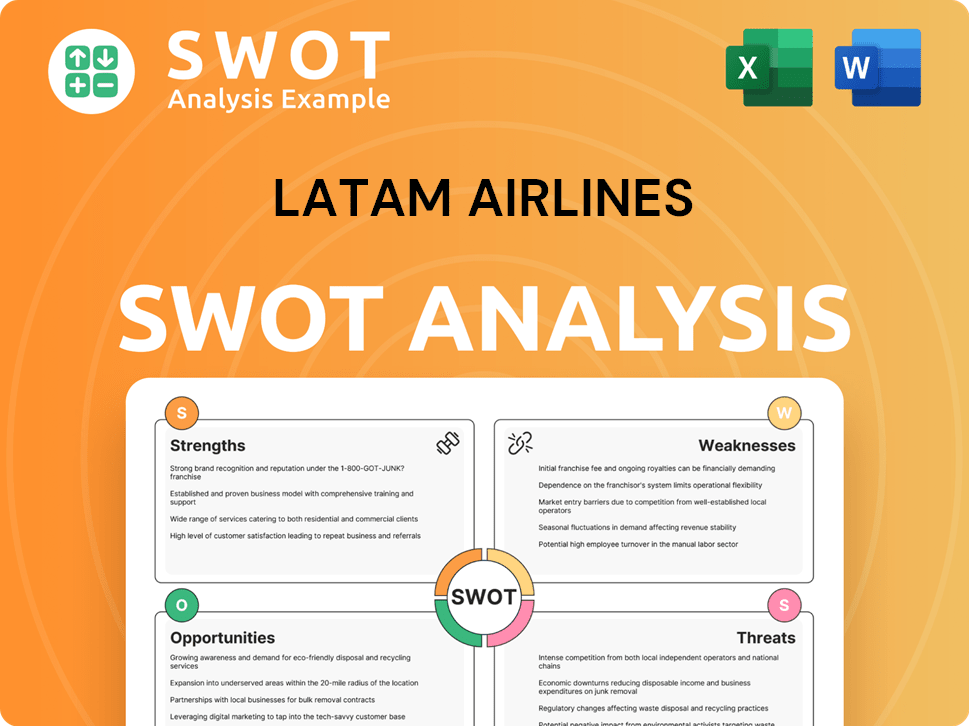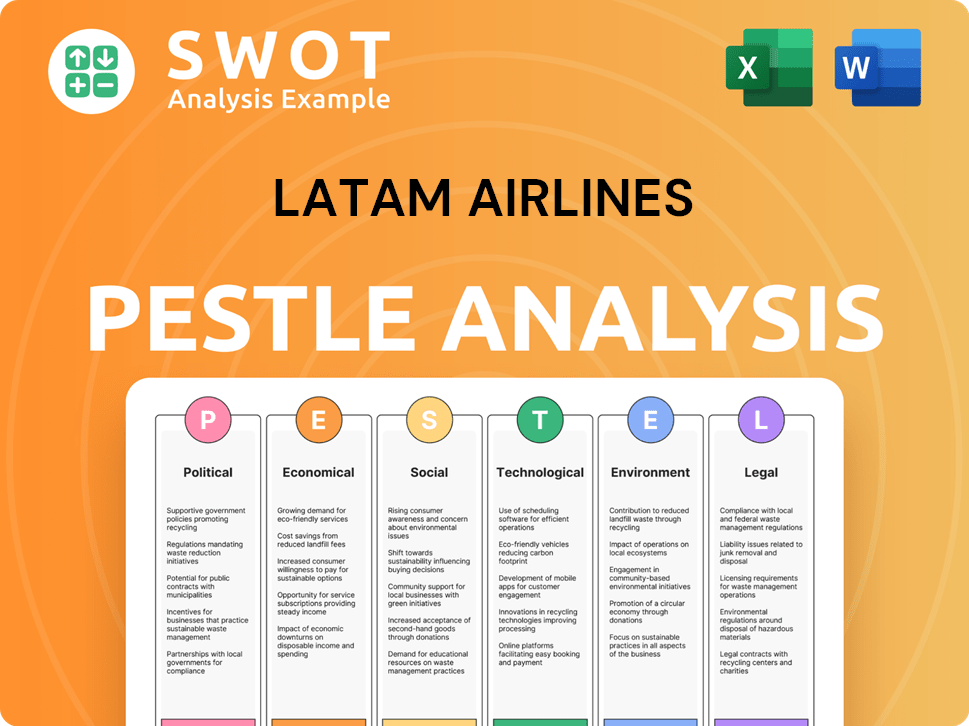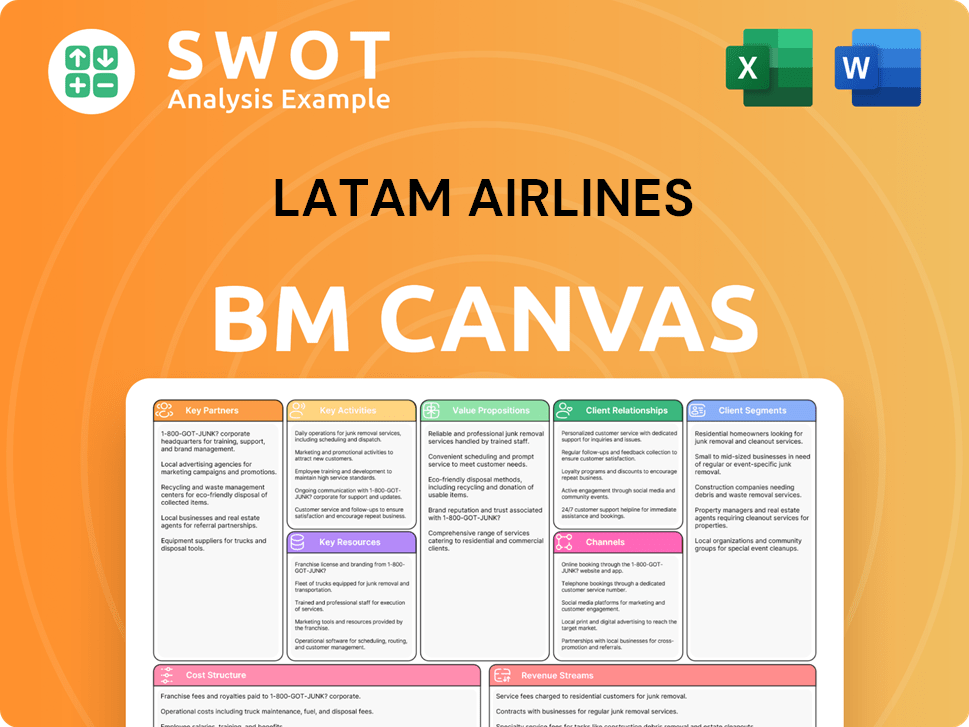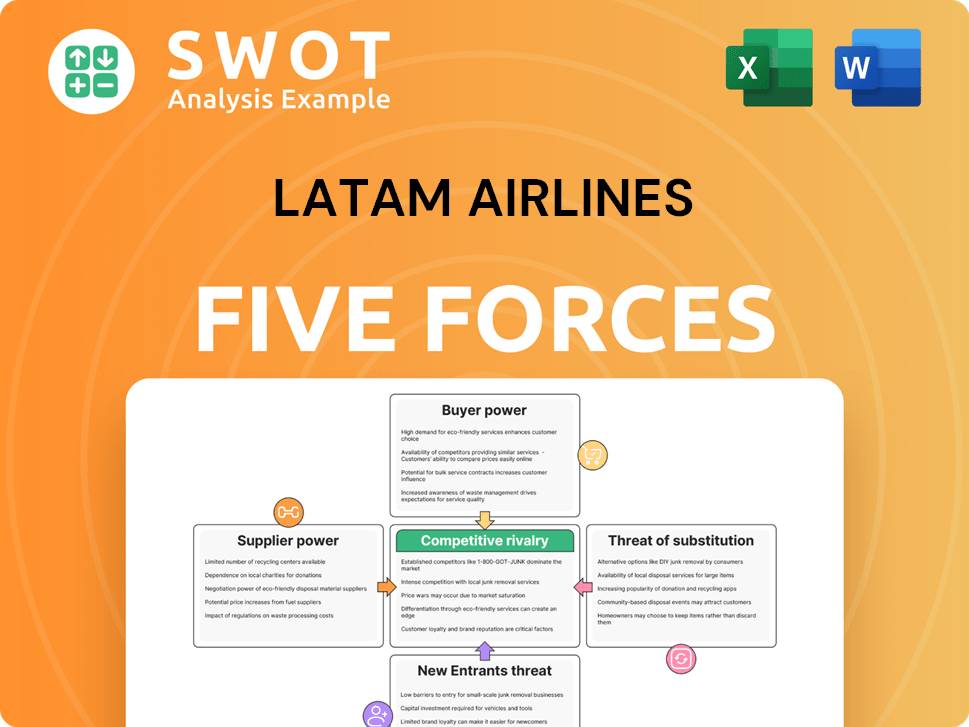Latam Airlines Bundle
Can LATAM Airlines Maintain Its Dominance in Latin America's Skies?
The Latin American airline industry is a battleground of fierce competition, constantly reshaped by economic shifts and evolving passenger expectations. LATAM Airlines Group, a powerhouse born from a strategic merger, has long held a leading position. This analysis dives deep into the Latam Airlines SWOT Analysis, exploring its competitive landscape and the forces shaping its future.

Understanding the Latam Airlines Competitive Landscape is crucial for investors and industry watchers alike. This report meticulously examines Latam Airlines Competitors, assessing their strengths and weaknesses, and evaluating Latam Airlines Market Share within the dynamic Airline Industry Latin America. We'll explore the company's strategic maneuvers, its financial performance, and its ability to navigate the challenges and seize the opportunities present in the Airlines in South America market, providing a comprehensive Latam Airlines Analysis.
Where Does Latam Airlines’ Stand in the Current Market?
LATAM Airlines Group maintains a strong market position within the Latin American aviation sector. The company is a leading player in passenger traffic and cargo volume, particularly in key South American markets. As of late 2024 and early 2025, it continues to hold a significant share of the market, demonstrating its importance in the Airline Industry Latin America.
The company's core operations encompass extensive domestic and international passenger air transportation, complemented by a robust cargo operation. LATAM Airlines' value proposition centers on providing comprehensive air travel services across a wide network, with a focus on connectivity within South America and to global destinations. This is supported by strategic route planning and fleet optimization.
LATAM Airlines Group reported a substantial increase in passenger traffic in 2024, with RPK (Revenue Passenger Kilometers) growing by 21.3% in the first nine months of the year compared to the same period in 2023, reaching 112.5 billion. Its load factor also improved, reaching 85.3% for the first nine months of 2024. The company's strategic adjustments and focus on digital transformation initiatives aim to enhance customer experience and operational efficiency.
LATAM Airlines holds leading market shares in several South American countries, including Brazil, Chile, Peru, Ecuador, and Colombia. This strong presence underscores its dominance in the region. The company's extensive route network and fleet size contribute to its market share, making it a key player in the Airlines in South America.
LATAM's primary geographic focus is South America, where it maintains a strong presence. The company strategically adjusts its positioning to meet market demands and competitive pressures. This includes expanding its network to underserved routes and optimizing its fleet for efficiency, which is crucial for Latam Airlines Analysis.
For the first nine months of 2024, LATAM Airlines Group reported total operating revenues of $9.48 billion, an increase of 24.3% compared to the same period in 2023, with a net profit of $491.5 million. This financial performance positions LATAM favorably against regional peers. The company's recovery and strengthening are indicative of its resilience.
LATAM focuses on digital transformation to enhance customer experience and operational efficiency. The company has optimized its fleet for efficiency and expanded its network to underserved routes. These strategic moves help LATAM Airlines maintain its competitive edge in the aviation market. You can read more about the company's background in Brief History of Latam Airlines.
LATAM Airlines faces competition in certain routes, particularly to North America and Europe. Global carriers have established strong footholds in these markets. The company’s ability to navigate these competitive pressures is critical for sustained success.
- Competition from global and regional airlines.
- Strategic route planning and network expansion.
- Focus on digital transformation and customer experience.
- Financial performance and recovery from previous challenges.
Latam Airlines SWOT Analysis
- Complete SWOT Breakdown
- Fully Customizable
- Editable in Excel & Word
- Professional Formatting
- Investor-Ready Format

Who Are the Main Competitors Challenging Latam Airlines?
The Latam Airlines Competitive Landscape is shaped by a diverse set of rivals, both regional and global. Understanding these competitors is crucial for assessing the airline's market position and strategic challenges. The Airline Industry in Latin America is highly competitive, with several key players vying for market share.
Latam Airlines' Market Share is influenced by its ability to compete effectively against these rivals, manage costs, and offer attractive services. The strategic alliances and partnerships, such as the one with Delta Air Lines, are vital in strengthening its competitive edge. A thorough Latam Airlines Analysis involves evaluating its performance against its main competitors.
Who are Latam Airlines' main rivals? The competitive landscape for the airline includes a mix of regional and international carriers. The airline faces competition from both established airlines and emerging low-cost carriers. The competitive dynamics are constantly evolving due to mergers, alliances, and shifts in market conditions.
In the Latin American market, the airline competes directly with regional carriers. These airlines often have a strong presence in specific countries or regions. Key regional competitors include Azul S.A., GOL Linhas Aéreas Inteligentes S.A., and Avianca.
Azul operates a hybrid model, serving both major cities and smaller regional destinations. They have a strong domestic network, particularly in Brazil. Azul's strategy focuses on expanding its route network and offering competitive fares.
GOL emphasizes a low-cost model, especially within Brazil. They challenge the airline on price-sensitive routes. GOL focuses on efficiency and cost management to maintain its competitive position.
Avianca is a significant player in the Andean region, competing on numerous international and domestic routes. Their Star Alliance membership helps them compete effectively. They focus on expanding their international presence and enhancing customer service.
The airline also competes with major global airlines, particularly on long-haul international routes. These airlines leverage their extensive international networks and brand recognition. Global competitors include American Airlines, Delta Air Lines, and United Airlines.
American Airlines, Delta Air Lines, and United Airlines are key competitors on routes to and from North America. They often have strong loyalty programs and extensive route networks. The joint venture between the airline and Delta Air Lines aims to strengthen their competitive position.
Several factors influence the competitive dynamics within the Airlines in South America and beyond. These factors affect the airline's ability to attract and retain customers. Understanding these factors is essential for strategic planning.
- Pricing Strategies: Competitive pricing is crucial for attracting price-sensitive travelers. Airlines regularly adjust fares based on demand and competitor pricing.
- Route Network Analysis: The breadth and depth of the route network are critical. Airlines with extensive networks can offer more destinations and better connectivity.
- Customer Satisfaction Ratings: High customer satisfaction can lead to increased loyalty and positive word-of-mouth. Airlines invest in improving customer service and experience.
- Strategic Alliances: Partnerships with other airlines can expand reach and offer more competitive pricing. Alliances like the one with Delta Air Lines are important.
- Impact of Fuel Prices: Fuel costs significantly affect profitability. Airlines often use hedging strategies to manage fuel price volatility.
- Expansion Plans: Airlines regularly announce expansion plans to increase their market share. These plans include new routes and fleet expansions.
For more information on the airline's target market, you can read about the Target Market of Latam Airlines.
Latam Airlines PESTLE Analysis
- Covers All 6 PESTLE Categories
- No Research Needed – Save Hours of Work
- Built by Experts, Trusted by Consultants
- Instant Download, Ready to Use
- 100% Editable, Fully Customizable

What Gives Latam Airlines a Competitive Edge Over Its Rivals?
Understanding the competitive landscape of Latam Airlines is crucial for investors and industry analysts. The company, a major player in the Airline Industry Latin America, faces a dynamic market. Analyzing its competitive advantages, including its market share and strategic positioning, provides valuable insights. This analysis helps in evaluating its resilience and growth potential amidst evolving challenges.
Key milestones, strategic moves, and the competitive edge of Latam Airlines are essential for understanding its market dynamics. The airline has navigated through significant industry shifts, including mergers and economic fluctuations. Its strategic decisions, such as route expansions and partnerships, have shaped its competitive standing. Examining these factors reveals Latam Airlines' ability to adapt and thrive in a competitive environment.
This chapter delves into the specific competitive advantages that Latam Airlines leverages to maintain its position in the Latin American aviation market. The focus will be on its extensive network, brand equity, customer loyalty, strategic partnerships, cargo operations, and digital transformation initiatives. By understanding these strengths, stakeholders can better assess Latam Airlines' ability to compete effectively and capitalize on opportunities in the Airline Industry Latin America.
Latam Airlines boasts an unparalleled network within Latin America. This extensive network provides superior connectivity across key markets such as Brazil, Chile, Peru, Colombia, and Ecuador. The company's strategic hubs in cities like São Paulo and Santiago further enhance its ability to connect passengers and cargo. This broad reach is a key factor in its competitive advantage.
Latam Airlines benefits from strong brand recognition and customer trust, a legacy of its origins. Its loyalty program, LATAM Pass, is one of the largest in the region, fostering repeat business. This strong brand equity and customer loyalty contribute significantly to its market position and ability to attract and retain passengers.
The joint venture with Delta Air Lines significantly enhances Latam Airlines' global reach. This partnership allows it to offer a more comprehensive network and seamless travel experiences. Strategic alliances are crucial for expanding its market presence and providing competitive offerings to passengers traveling between North and South America.
Latam Airlines' cargo operations provide diversified revenue streams. These operations leverage the passenger fleet's belly capacity, alongside dedicated freighter aircraft. The extensive air freight services across the Americas and beyond give it a competitive edge. This is especially important for the company's financial performance compared to competitors.
Latam Airlines' competitive advantages are multifaceted, contributing to its strong market position and ability to navigate challenges. The company's extensive route network, brand strength, and strategic partnerships are key differentiators. These elements, combined with a focus on customer experience and operational efficiency, support its long-term sustainability and growth.
- Extensive Network: Latam Airlines operates a vast network, offering connectivity across key Latin American markets. This extensive reach allows for efficient passenger and cargo transport, giving it a competitive advantage over smaller airlines.
- Brand Recognition: The airline benefits from strong brand recognition and customer loyalty, cultivated over years of service. This trust is a valuable asset in attracting and retaining passengers in a competitive market.
- Strategic Partnerships: Partnerships, such as the joint venture with Delta Air Lines, enhance its global reach. These alliances provide passengers with more comprehensive travel options and improve Latam Airlines' competitive offering. The Growth Strategy of Latam Airlines further details these strategic moves.
- Cargo Operations: Latam Airlines' cargo operations contribute significantly to its revenue and market share. The ability to transport cargo efficiently leverages its fleet and network, making it a key player in air freight.
Latam Airlines Business Model Canvas
- Complete 9-Block Business Model Canvas
- Effortlessly Communicate Your Business Strategy
- Investor-Ready BMC Format
- 100% Editable and Customizable
- Clear and Structured Layout

What Industry Trends Are Reshaping Latam Airlines’s Competitive Landscape?
The competitive landscape for LATAM Airlines Group in the Latin American airline industry is dynamic, shaped by technological advancements, regulatory changes, and evolving consumer preferences. Understanding these trends is crucial for assessing LATAM's market position, the risks it faces, and its future outlook. The airline industry in Latin America is subject to fluctuations in fuel prices, currency volatility, and economic instability, which can significantly affect operational costs and passenger demand.
LATAM Airlines' competitive environment is influenced by both internal and external factors, including the company's strategic alliances, fleet modernization efforts, and digital transformation initiatives. The airline's ability to navigate these challenges and capitalize on opportunities will determine its long-term success. The ongoing expansion of the cargo business, driven by e-commerce growth, offers a promising avenue for revenue growth, which supports the Growth Strategy of Latam Airlines.
Technological advancements, particularly in digitalization and sustainable aviation, are profoundly impacting the sector. There is a growing demand for seamless digital experiences, from booking to in-flight services. The increasing focus on environmental sustainability is a significant trend, with airlines facing pressure to reduce carbon emissions. Regulatory changes, including those related to consumer protection and environmental standards, also play a crucial role.
Heightened competition from new low-cost carriers entering the market or expanding their operations poses a significant challenge. Ongoing volatility of fuel prices and currency fluctuations can impact operational costs. Economic instability in key Latin American markets can suppress demand for air travel. Adapting pricing strategies and service models to meet evolving consumer preferences is also a key challenge.
Emerging markets within Latin America offer significant growth opportunities, particularly as middle-class populations expand. Innovation in ancillary services, such as enhanced loyalty programs, presents avenues for revenue growth. The continued expansion of the cargo business, driven by e-commerce growth, provides another promising avenue. Strategic alliances, like the joint venture with Delta Air Lines, are crucial for network optimization and increased market share.
LATAM's strategic alliances are crucial for navigating industry trends, allowing for network optimization and increased market share. The company’s ability to invest in fleet modernization, digital transformation, and sustainable practices will be critical in maintaining its competitive position. The airline must adapt its pricing strategies and service models to meet evolving consumer preferences. LATAM must also manage the impact of fuel prices and currency fluctuations.
LATAM Airlines faces both internal and external factors that shape its competitive landscape. The airline needs to leverage its strategic alliances, such as the joint venture with Delta Air Lines, to optimize its network and increase market share. The company must focus on fleet modernization, digital transformation, and sustainable practices to maintain its competitive position and capitalize on future growth.
- Latam Airlines Market Share: The airline must continuously monitor and adapt to changes in market share.
- Latam Airlines Competitors: Identifying and understanding competitors, including low-cost carriers, is crucial.
- Airlines in South America: The focus on the South American market is essential for growth.
- Latam Airlines competitive advantages: Innovation in ancillary services and cargo expansion are key.
Latam Airlines Porter's Five Forces Analysis
- Covers All 5 Competitive Forces in Detail
- Structured for Consultants, Students, and Founders
- 100% Editable in Microsoft Word & Excel
- Instant Digital Download – Use Immediately
- Compatible with Mac & PC – Fully Unlocked

Related Blogs
- What are Mission Vision & Core Values of Latam Airlines Company?
- What is Growth Strategy and Future Prospects of Latam Airlines Company?
- How Does Latam Airlines Company Work?
- What is Sales and Marketing Strategy of Latam Airlines Company?
- What is Brief History of Latam Airlines Company?
- Who Owns Latam Airlines Company?
- What is Customer Demographics and Target Market of Latam Airlines Company?
Disclaimer
All information, articles, and product details provided on this website are for general informational and educational purposes only. We do not claim any ownership over, nor do we intend to infringe upon, any trademarks, copyrights, logos, brand names, or other intellectual property mentioned or depicted on this site. Such intellectual property remains the property of its respective owners, and any references here are made solely for identification or informational purposes, without implying any affiliation, endorsement, or partnership.
We make no representations or warranties, express or implied, regarding the accuracy, completeness, or suitability of any content or products presented. Nothing on this website should be construed as legal, tax, investment, financial, medical, or other professional advice. In addition, no part of this site—including articles or product references—constitutes a solicitation, recommendation, endorsement, advertisement, or offer to buy or sell any securities, franchises, or other financial instruments, particularly in jurisdictions where such activity would be unlawful.
All content is of a general nature and may not address the specific circumstances of any individual or entity. It is not a substitute for professional advice or services. Any actions you take based on the information provided here are strictly at your own risk. You accept full responsibility for any decisions or outcomes arising from your use of this website and agree to release us from any liability in connection with your use of, or reliance upon, the content or products found herein.